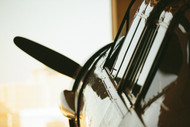Why you can't fix your plane with just any parts
By on Jun 6th 2018
Routine certified aircraft maintenance is an important aspect of owning a plane. This makes owning an aircraft different from any motor vehicle. What really distinguishes plane maintenance, though, is the required use of FAA-approved parts.
Various aircraft parts and materials may be "standard parts," which the FAA defines as "a part or material that conforms to an established industry or U.S. Government-published specification." Standard parts need to be accepted as an "approved part" to be used on a certified aircraft. Such approval is based on the part's certification and whether it has "been designed and produced in accordance with an independent established set of specifications and criteria," according to the FAA.
Essentially, this means that you must use very specific parts in the maintenance of your plane; these parts must be approved for use by the FAA. This also means that while you can swing by your local auto parts store, dealer, or junkyard to fix your sedan, there is no airplane maintenance equivalent.
Given the concerns over safety and reliability while flying, the FAA mandates that all parts installed in a certified airplane must be traceable to an FAA-approved manufacturer. Additionally, you must also keep the approval documentation for all parts installed on the plane in the aircraft maintenance records. This mandate applies to all functioning and even non-functioning parts such as upholstery and carpeting. Legally, these materials must be approved for fire resistance).
Bogus aircraft parts
If you use components that don't follow the approved part guidelines, these are unapproved or bogus aircraft parts.
These terms refer to a few different categories of aviation parts. Unapproved/bogus aircraft parts can range from substandard components and counterfeits to working parts that simply did not follow all FAA regulations to the letter. These can also include surplus parts sold at discounted prices (and thereby bypassing the FAA's strict quality control systems).
These are the five standards for installing parts on FAA-certified products:
- Have FAA approval that is documented and kept in aircraft maintenance records
- Are suitable for installation purposes
- Have been installed corrected
- They are function-tested and work properly
- Maintenance records are complete and show the work accomplished, the function test performed, and proof that a properly certificated person or facility approved the work for the return to service.
How an aircraft part receives approval
In the United States, there are a few ways aircraft parts can be approved to meet FAA standards for use in certified aircraft. An aircraft part can have approval by the following:
- the original manufacturer;
- under a Parts Manufacturers Approval (PMA) by an after-market manufacturer;
- as part of a Supplemental Type Certificate (STC) by an after-market manufacturer;
- by meeting the requirements of a Technical Standard Order (TSO) by an after-market manufacturer;
- approved by an FAA Field Approval (FAA Form 337);
- have a "blanket" approval by meeting an accepted industry standard, such as a "MIL spec"
In the name of safety
The use of unapproved parts can present a serious safety concern. In some instances, bogus aircraft parts caused aviation crashes. The 1989 crash of Partnair Flight 394, for example, occurred when counterfeit bolts holding the vertical stabilizer of a Convair CV-580 in place wore down excessively. This wear and tear allowed the tail to vibrate excessively and eventually break off. All fifty passengers and five crew members on board died.
Of course, prior to 1958, there was no Federal Aviation Administration for regulating aviation safety. Before there was any oversight, pilots who wanted to build themselves an airplane did so with what they had on hand. Often, these were automotive parts, but sometimes they weren't parts from any type of vehicle. Lilian Bland, for example, steered her home-built aircraft with a bicycle handlebar and even devised a temporary fuel system out of a whiskey bottle and an ear trumpet.
Given the given the increased speed, technological advancements, and the sheer number of aircraft in the skies today, maintaining safety standards is paramount. Breaking down on the side of the highway due to faulty parts is one thing; having a similar incident while flying over the Atlantic Ocean is something else entirely.
NBC Bay Area has done an investigation looking into the use of bogus aircraft parts on commercial planes, which you can read about here.







